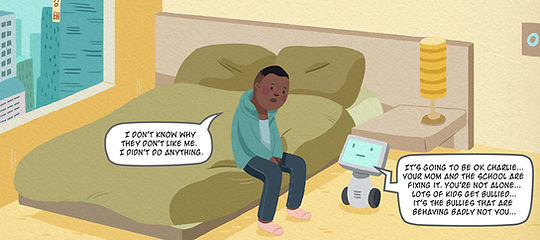
SCIENCE FICTION
PROTOTYPING
Science Fiction Prototyping uses imaginative storytelling grounded in scientific fact to envision future technologies and explore their potential impact on society. By embedding new technology ideas within narratives, this approach allows researchers and futurists to test and assess innovations in realistic future settings. These story-based "prototypes" help explore how emerging technologies might shape lives, environments, and industries, offering valuable insights into their development and societal implications.
At Winkstink Design, we transform these insights into visually dynamic and engaging stories, ultimately presented as graphic novels or motion comics. By crafting a creative and immersive experience, we help readers understand the potential benefits and threats these technologies pose to society, making complex concepts accessible and thought-provoking.

DARK AZIMUTH
Dark Azimuth is a speculative science fiction prototype developed in collaboration with T2S Solutions, visualizing the future of space warfare and rapid-response satellite deployment. This 10-page visual narrative showcases a near-future conflict where U.S. space assets are crippled by hostile anti-satellite strikes. Winkstink Design transformed complex defense concepts into compelling narrative visuals, merging hard science and creative speculation to explore tomorrow’s battlespace at the intersection of technology, timing, and tactical innovation.

INVISIBLE FORCE: INFORMATION WARFARE AND THE FUTURE OF CONFLICT
The year is 2030. Large swaths of the world are destabilized. Famine is rampant due to the aftermath of the long legacy of failed globalization. Citizens from poorer countries are migrating to escape famine, war, climate change, and lack of opportunity created by failed states. Wealthier countries, worried about resource scarcity, close themselves off to the refugees.

Amid all of this, quantum computing has been achieved, resulting in infinitely faster processing of more information than ever before. Quantum technology and a fracturing of the global alliances enable global elite to exercise control over information - resulting in a segmented Internet. Nations are now ruled by technocratic elites, some who remain committed to individual liberty and privacy, and others who extract data as a raw material from the lives of individuals, with no restrictions on its use other than profit.
By 2030, the nature of information war has changed. Combined with new, ubiquitous technology and levels of individual customization from data extraction, people don’t even realize they’re being manipulated.


DARK HAMMER: A RETROSPECTIVE OF SCIENCE FICTION PROTOTYPING
Graphic novellas are a medium with a rich tradition of use by the U.S. Army. For generations, the Army has successfully used this medium for conveying important messages across the force. Today, the Army Cyber Institute is continuing this tradition based on science fiction prototypes of cyber threats it may encounter on future battlefields. This retrospective book discusses the Army’s historical use of the medium, and how it is being applied as a tool for educating the modern cyber force.

Science Fiction Prototypes are science fiction stories based on future trends, technologies, economics, and cultural change. The stories you are about to read are based on threatcasting research from the Army Cyber Institute at West Point and Arizona State University’s Threatcasting Lab. Our stories do not shy away from a dystopian vision of tomorrow. Exploring these dark regions inspires us to build a better, stronger, and more secure future for our Armed Forces.


CISCO PRESENTS: TO SAVE TOMORROW - ENVISIONING THE FUTURE OF WORK
The Future of Work is a huge topic. How will we attract and retain the worker of the future? How can we leverage the latest technology to augment the worker of the future? What will the workplaces of the future be like? It’s the subject of conferences, white papers, speculation, pontificating, and hand-wringing. Yet with all the talk, most of us have a hard time picturing the future in a way that brings the all high-flying ideas down to earth. We’re not wired to imagine what the world might be like in ten or twenty years time… maybe such a long term view wasn’t helpful for us back when we were cavemen…

These Science Fiction Prototypes make it easier to visualize the future in a concrete way so that we can more easily identify areas that are ripe for innovation. Who will be the workers of the future, and how will their needs and expectations change? What will be the role of robotics, AI, and virtual reality? What risks will we need to navigate?

MICROSOFT PRESENTS: BULLY
“Bully” explores the intersection of modern cyber threats and personal resilience in a near-future world. Set in 2029, it follows 10-year-old Charlie, who moves from Mississippi to a smart city in Seoul, South Korea. Struggling to adjust, Charlie becomes the target of relentless cyberbullying, escalating when fake videos and coordinated troll attacks surface, threatening his sense of identity and safety.

As the bullying intensifies, both Charlie’s Ai assistant and his mother’s workplace systems intervene, discreetly alerting her to the situation. With the help of local support networks and technology, the family begins uncovering the foreign troll operations behind the attacks while learning to navigate the emotional and societal impacts of this new era of cyber threats. “Bully” examines the challenges of living in a hyper-connected world and the crucial role of ethical Ai and human empathy in combating misinformation and harassment.